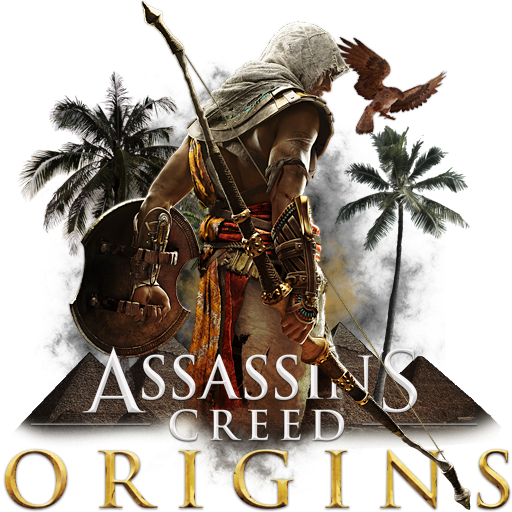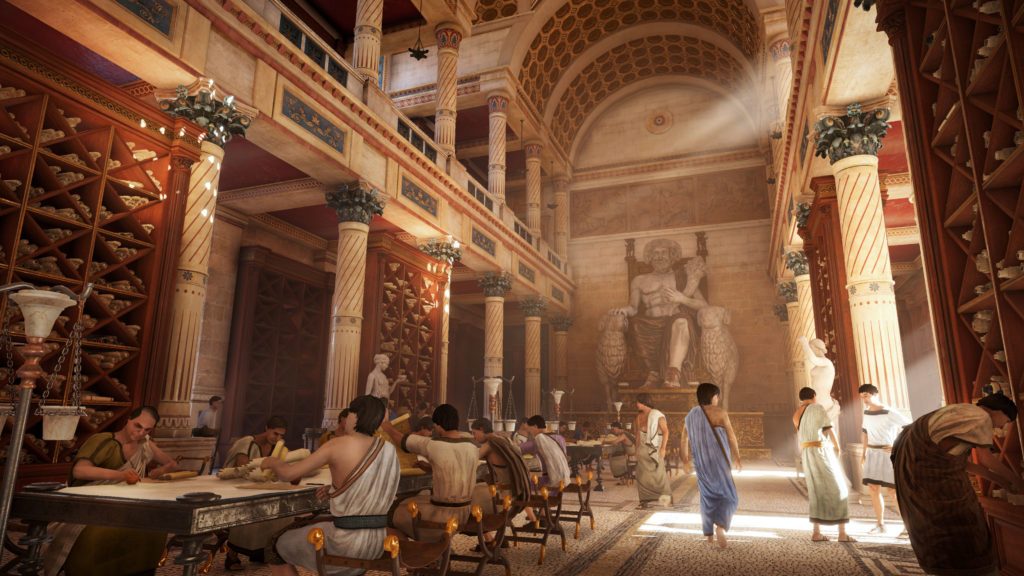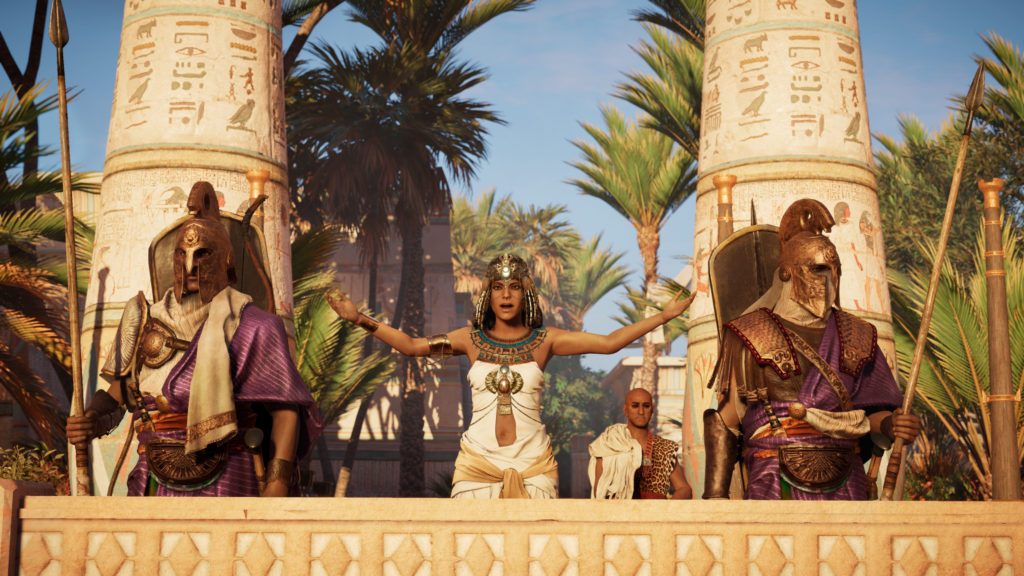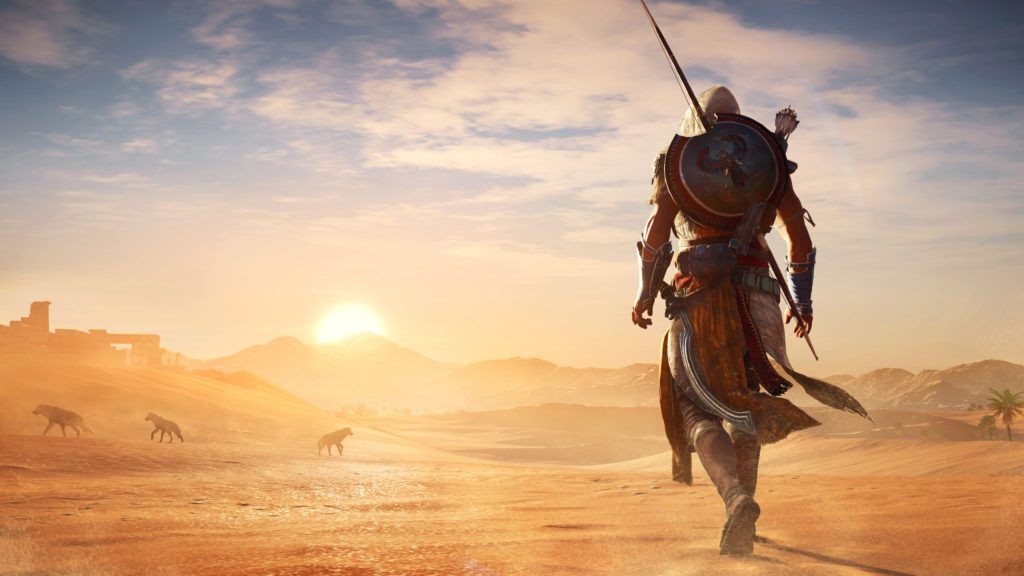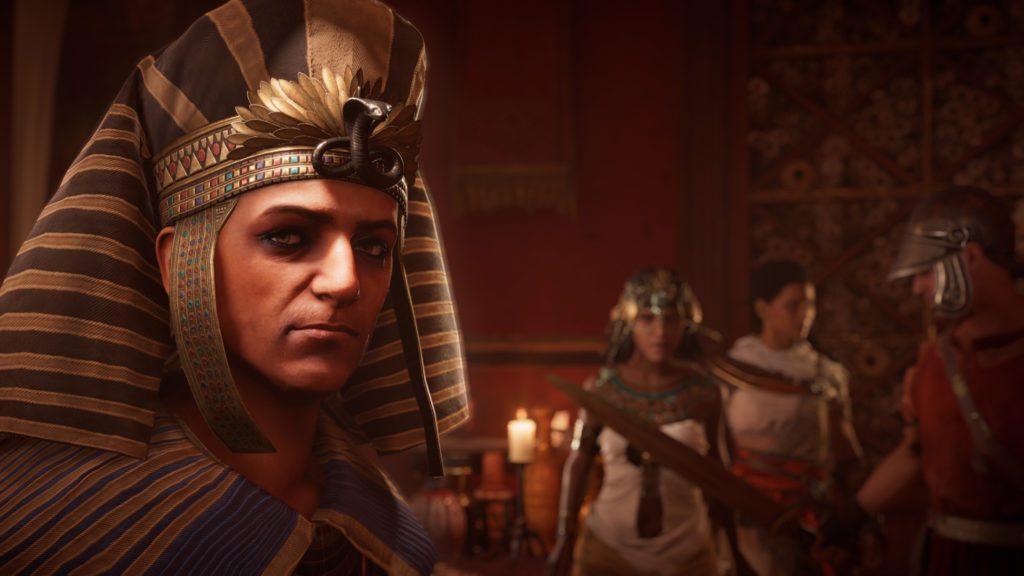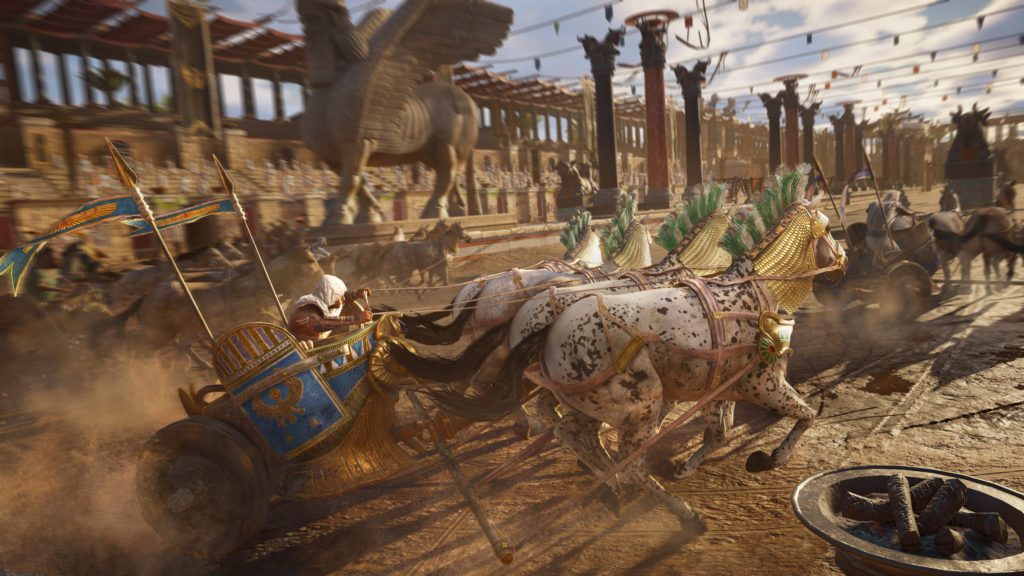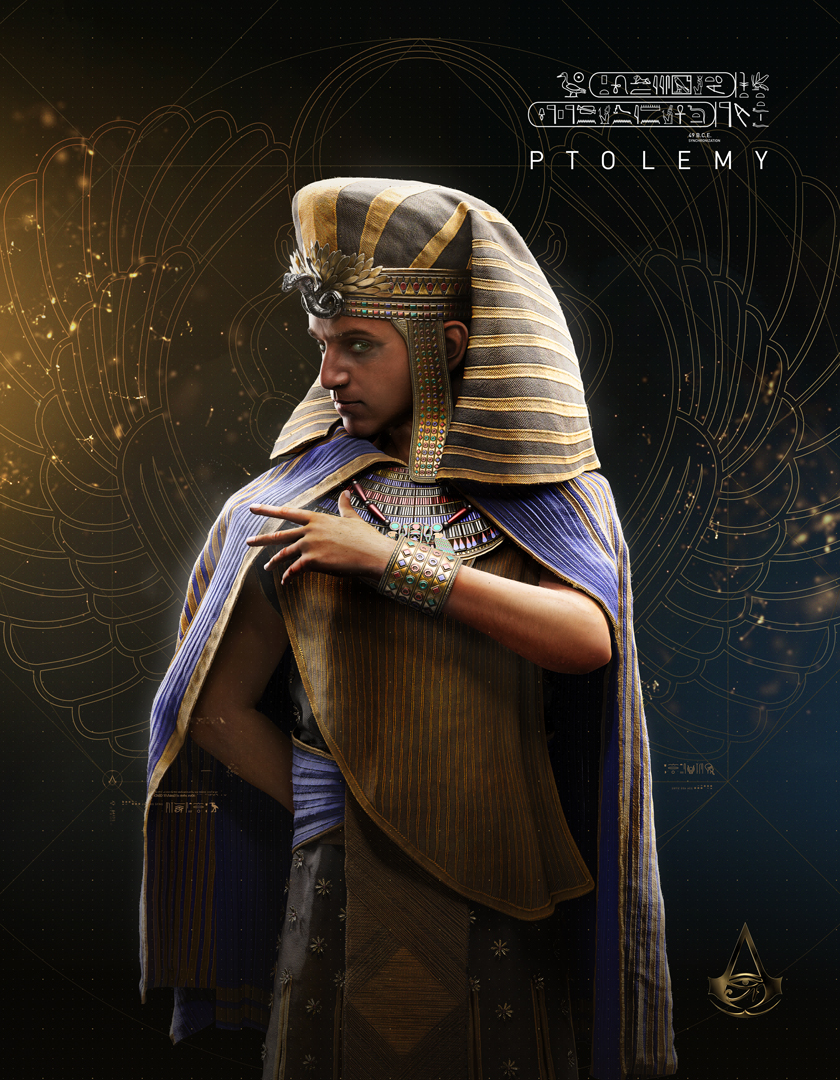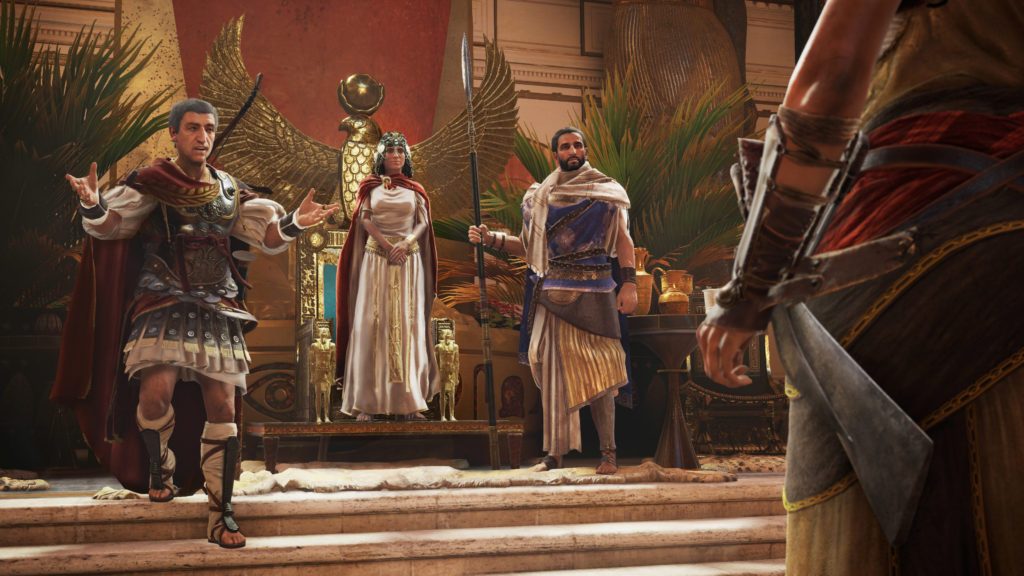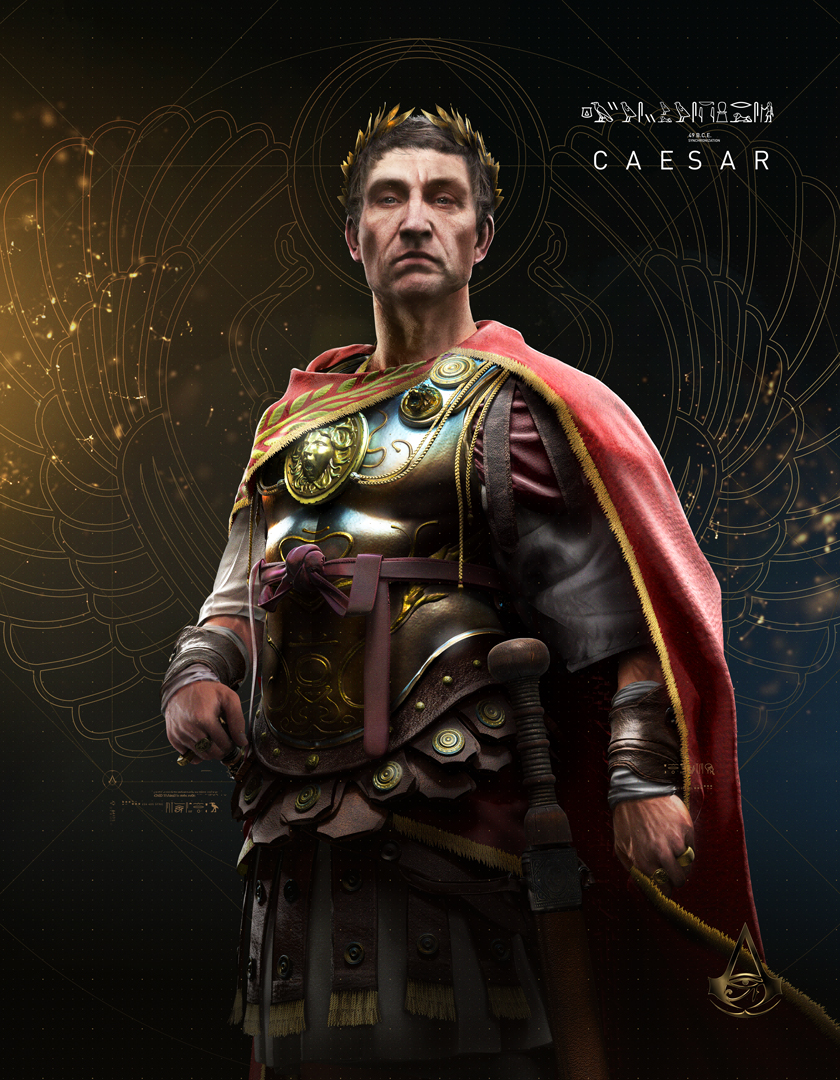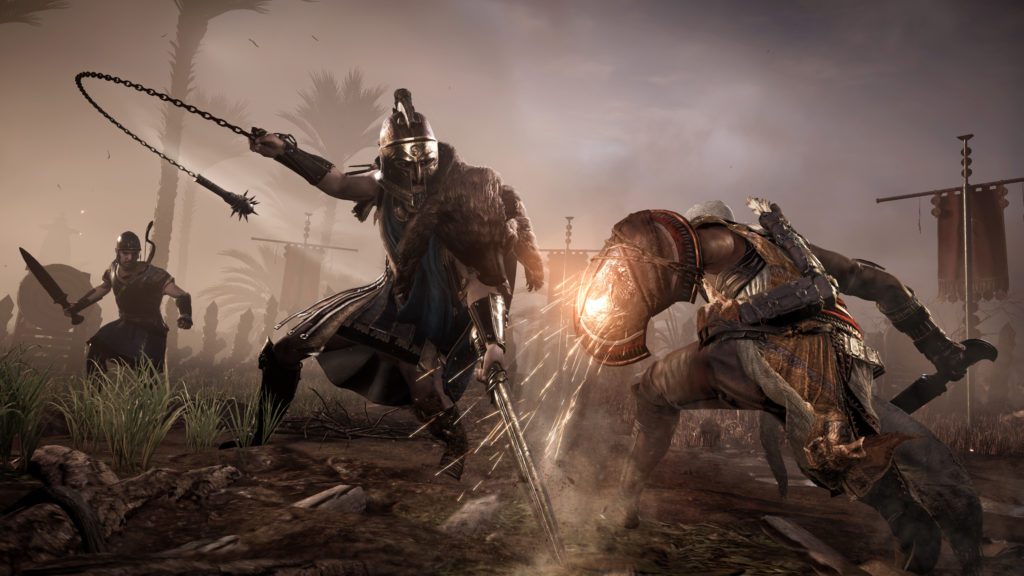Assassin’s Creed: Origins Gamescom 2017 ‘Game of Power’ Trailer and Screens
In re-creating ancient Egypt, Assassin’s Creed Origins doesn’t just give players a city or three to explore, with some countryside in between – it’s building an entire seamless country that you’ll be able to travel freely across, from Alexandria and the Nile Delta in the north to Faiyum in the south. This is the biggest world ever created for an Assassin’s Creed game, and it’s packed with dynamic things to discover and pursue.
“When we started saying ‘let’s do Ancient Egypt,’ it was going to be [the entire] country,” says Ashraf Ismail, game director of Assassin’s Creed Origins. “Ancient Egypt meant many things for us; it meant cities, but also wilderness, and we wanted to show the diversity of this wilderness. And people, as they play the game and get into hours and hours of it, they’re constantly seeing new stuff from the world and the environment.”
The team began with a world around the size of Assassin’s Creed IV: Black Flag’s, with one key difference: it’s almost all land, and the parts that aren’t land are fully realized underwater environments that hide secrets, loot, and dangerous animals. And no matter where you are, there’s a density to the landscape that creates the feeling that there’s always some area you haven’t explored, something you haven’t uncovered.
For example, the game’s city of Memphis is a massive, almost mazelike landscape of temples, fortresses, and dwellings. Delving into any of these can lead to battles, treasure, new weapons, secret caves, and more, lending importance to every structure, every person, and every opportunity to wander off the beaten path. And all of this is a seamless part of the larger open world, surrounded by miles of farmland, rocky desert, cliffs, and gigantic pyramids that conceal mysteries of their own.
“In terms of the granularity of the details, the experiences that you can have, the things you can run into, the NPCs, the animals, the fauna, it’s much, much more dense,” says Ismail. “This is definitely, in terms of content, the biggest world we’ve ever built. We want the exploration of the world to really be jaw-dropping. We want people to be lost in this world for hours and hours. So the game is quite huge. The world is massive.”
REVIVING THE ANCIENT WORLD
Egypt, even in the game’s setting of 49 BCE , was never the undifferentiated landscape of deserts, pyramids, and snazzy headgear so often portrayed in fiction. It was huge and cosmopolitan, and its status as a hub of trade, agriculture, and craftsmanship made it a giant among the cluster of ancient civilizations that huddled around the Mediterranean. From Alexandria to Memphis, Egypt was a place of geographical contrasts and cultural diversity, and re-creating the entire country as a single open world is one of Assassin’s Creed Origins’ greatest achievements.
“When you compare the game’s map to the real-world map, when you look at it very quickly, you feel like this is Egypt,” says Maxime Durand, Assassin’s Creed Origins’ resident historian. “The proportions make sense. You have the Nile to the east, you have the deserts down south and west, you have the Libyan Plateau out west of Alexandria.
“When you look at precise points, you realize that we play a lot with size and the distances,” says Durand. “But wherever you are in the world, you know where you’re located. You have landmarks to look at and orient yourself. You can see some of the mountains to help you understand where you are. You can use the pyramids to know where you’re at or the Lighthouse in Alexandria.
“We have different regions in the game that are inspired by history, inspired by real places,” adds Durand. “All of these regions are unique. They have their own flavor and their own people.”
Egypt’s diversity wasn’t just geographical. In 49 BCE, Durand says, the country’s population was a mix of native Egyptians and pockets of Greeks, with the latter population tending to cluster in certain areas around Egypt. Greeks had been part of Egypt’s cultural makeup for about 1,500 years before the events of Assassin’s Creed Origins. After Egypt’s conquest by Alexander the Great in 332 BCE , however, one of his generals, Ptolemy, installed himself as the founder of a new dynasty of pharaohs. As a result, Greeks had lived in Egypt as a privileged class for more than 250 years, and their influence had a dramatic effect on the country’s landscape.
Assassin’s Creed Origins’ version of Faiyum, for example, is an area that had seen a relatively recent population explosion thanks to the Ptolemies expanding its irrigation system. This led to a huge influx of both Greeks and Egyptians, whose coexistence created a landscape where Greek villas and pavilions bump up against Egyptian temples and statuary. Other areas will have their own distinct character; Memphis, the old capital of the pharaohs, was about as traditionally Egyptian an example as you can get, a place where few Greeks lived and the country’s ancient religious traditions were closely guarded by Egyptian high priests. Alexandria, meanwhile, was the relatively new capital of the Ptolemies, and as such was where most of Egypt’s Greek population lived. Rather than being a bastion of Greek customs, however, Alexandria was the center of a new Greco-Egyptian culture that combined both traditions to create something unique to Egypt.
To represent these areas in the game, Durand says, the developers consulted Egyptologists and studied a wide variety of materials on ancient Egypt, including movies and comic books as well as historical texts and documentaries. Their research helped them move beyond clichéd depictions of Egypt, even going so far as to shape the unique topographies of the game’s vast deserts.
“There are a lot of deserts, but a lot of them are unique,” says Durand. “They’re linked with reality because we studied them. We studied the Libyan Plateau, the Qattara Depression – all of these places that make Egypt what it is as a country.”
“One of my favorite places in the world is the White Desert, because it has these very uniquely structured rocks, and it’s built off of the real White Desert,” says Ismail. “The black desert, which is close by, is a very foreign environment that does feel a bit alien – and then the sand dunes, the classic image that people have, that area is just awesome. We have systems that run in these deserts, we try to make the desert experience feel unique in itself.”
Also vital is Siwa, Bayek’s home village, which plays a key role in Egypt’s history. Before invading Egypt, Alexander the Great traveled across hundreds of miles of desert to visit Siwa’s Oracle of Amun. The Oracle allegedly judged Alexander to be not only divine, but the legitimate Pharaoh of Egypt. That Alexander showed enough sensitivity to Egyptian custom to make the trip and be confirmed by the oracle made it easier for Egyptians to accept his rule, as well as that of his successor in Egypt, Ptolemy.
“When you look at Siwa on Google Maps , it’s insane how far it is,” says Durand. “It’s even more insane to think that Alexander the Great and the Ptolemies might have traveled just to go there, in the middle of nowhere, and come back to Alexandria. It’s so remote, but for us, it was important to have that in the game, because of the presence of the oracle.”
A COUNTRY FILLED WITH ACTIVITY
Next to capturing the scale and detail of Egypt, the game’s biggest task might be filling its vast spaces with interesting things to see and do. The Egypt of Assassin’s Creed Origins is a dynamic place, one where you’ll always be able to find wildlife to hunt, a secret to uncover, a bandit gang to raid, or a quest to pursue. In fact, you’ll need to discover the game’s quests on your own, and there are always multiple ways to do it; a vital contact might direct you to someone who wants you to check on a friend in danger, for example, or you might just stumble onto that friend while exploring and get pulled into a new adventure. You can even leave a quest at any time, pursue other tasks, and pick up again from where you left off.
“It’s a way to enhance the narrative experience, to create unique opportunities for missions, and to create setups with the new AI so our crowd has a 24-hour cycle and an agenda,” says Durand of the new quest system. “The AI creates unique experiences, and we don’t always know what’s going to happen. So you might be looking for a target, and actually he’s being eaten by a crocodile in the Nile, so you just need to find the proof that he’s dead. But for another player, they might actually need to find the target or interrogate him, or interrogate other people to locate that target. The new quest system allows us to create so many more characters and unique stories to tell to the players, which is really at the core of the Assassin’s Creed experience.”
Designing quests around this kind of dynamic world, Ismail says, is a very meticulous process. So is finding a balance between the fun of exploring the game’s spaces, and the need to make those spaces feel alive.
“For example, you might have some bandits that attack a little village,” Ismail says. “And as the player’s running through, whether they’re going to the village because of a quest, or because they need a shop, or because there’s a little puzzle to discover in this little village – whatever their reason is, the game is offering them many ways to engage with that village, systemically or through a quest. And here it’s about players being lost in the world, but still having the controls and the capacities to understand what is offered to them and how they can interact with it.”
There are plenty of side activities you can pursue more deliberately, too. Nosing around an old ruin, for example, might reveal a dark dungeon filled with puzzles and traps, which Bayek can explore for treasure and other rewards. The biggest standout activities so far, however, are gladiator arenas and hippodromes, ancient race courses that let Bayek compete at the reins of a four-horse chariot – “Ben Hur-level stuff,” says Ismail. The arena and hippodrome are both integrated into the main storyline, but quickly become optional activities that offer unique encounters and rewards, giving players the chance to test their skills and pursue ancient stardom whenever they want.
THE LAST PHARAOH
Assassin’s Creed Origins is set during the reign of Cleopatra, an extremely tumultuous and pivotal era for Egypt – and one that fits in well with the series’ preference for periods of conflict, upheaval, and massive societal change. In fact, Durand says, 49 BCE was a particularly bad time for Egypt. Cleopatra and her younger brother, Ptolemy XIII, had previously ruled Egypt together as its co-regents, but were now embroiled in a civil war for Egypt’s throne. This war coincided with a famine caused by years of bad harvests, as well as with an economic crash caused by the total devaluation of Egypt’s currency. This led Rome, Egypt’s longtime ally and creditor, to take an interest in calming things down – and as Rome’s own civil war ended abruptly on Egypt’s shores, Julius Caesar himself would famously take a side in Egypt’s raging conflict.
War and the larger-than-life historical personalities that controlled it aren’t the only reasons this era was chosen for Assassin’s Creed Origins, either. Egypt at this moment was a clash of old and new, caught in a transition between millennia of tradition and a rapid cultural upheaval that will change it forever, which makes it the ideal setting to tell the story of the birth of the Assassin Brotherhood as we now know it. It also doesn’t hurt that this is when the country was arguably at its most dynamic, diverse, and visually engaging, making it ripe for Assassin’s Creed’s unique brand of historical tourism.
“It’s a moment in time when the country is very, very green, because they irrigated more than they did after, and more than they did before. It really is the best time for them,” says Durand. “In terms of landmarks, this is also the time where you have the ancient Wonders of the World in better shape. You have the Lighthouse of Alexandria, the Pyramids of Giza. Then you have this Roman presence that’s just about to invade Egypt – it’s already being felt, because they’re everywhere. They’re just waiting to invade, for the perfect moment that’s going to come very soon.”
At the center of it all is Cleopatra herself. The last real Pharaoh of Egypt, she remains one of the most extraordinary and fascinating figures in history, and her machinations play a key role in the game’s story.
“What she did as a ruler of Egypt is unprecedented,” says Durand. “She was able to reclaim all of the possessions that had been lost by her ancestors. She was very agile in a very complex political game where she had very little power compared to a person like Julius Caesar. We know so little of Cleopatra, but the things we do know of her make her very interesting and fantastic. She was an incredible person.”
Incredible or no, she likely faced her share of rebellions, which had been a frequent problem for her ancestors – and which the developers are weaving into the game’s storyline. History doesn’t record any specific rebellions during Cleopatra’s reign, but the crushing conditions at the time – coupled with a social hierarchy that put Greeks at the top and gave native Egyptians little chance for upward mobility – had the makings of a powder keg of civil unrest.
“At the time of Cleopatra, there are no known rebels that are against the reign, and the reason for that is, if there were people that were rebels, their names were erased from history,” says Durand. “It’s most likely that there were a lot of rebellions back then; we know that they existed, we just don’t know the names of these people. We do know the names of some rebels from other time periods, during the reign of Cleopatra’s ancestors – one is Herwennefer, another is Ankhmakis. They are very popular in Egyptian history, and they were good sources of inspiration for the unique rebels in the game.”
“They would rebel mostly because of the burden of their taxes, because of Egypt’s bureaucracy,” adds Durand. “All of that was an inheritance of the pharaonic system, so it wasn’t new because there were Greek rulers. But at that precise moment, there were a lot of taxes, as well as a lot of battles linked with the dynastic wars. That is, wars inside Egypt against rebellions, and wars outside of Egypt, to protect other kingdoms that were owned by the Pharaohs. These wars needed a lot of men to fight them, and because they needed a lot of men, these men couldn’t work in the fields – but they still had to pay taxes. It was a source of very heavy frustration for a lot of people.”
That’s to say nothing of the civil war between Cleopatra and her brother, which history did record, and which wasn’t entirely unusual given the centuries of familial infighting, incest, and assassination that characterized the Ptolemaic dynasty.
“Pretty much everyone in Cleopatra’s ancestry had been killed, assassinated, drowned in the Nile, or something like that. All of them,” says Durand. “So in a very short amount of time, they changed the person on the throne very, very often and very quickly, and that created a lot of confusion and devalued the sacred Pharaoh. It tarnished the luster of rulers in Egypt.”
THE MASTER TACTICIAN
In the game, Ptolemy XIII appears to have the full support of a masked secret society calling itself the Order of the Ancients – and since history tells us the boy-king’s seizure of power was orchestrated mostly by his advisers, it’s likely the masked men are behind the civil war itself. In any case, Cleopatra would soon have a powerful ally of her own.
Cleopatra’s fortunes took a dramatic turn thanks to the intervention of Julius Caesar, then dictator of Rome. Caesar had come to Egypt chasing his rival (and former son-in-law) Pompey the Great, who’d fled after a decisive defeat that ended Rome’s latest civil war. Before Caesar’s arrival, however, Pompey was assassinated on the orders of Ptolemy XIII, who hoped to win influence with Caesar. Instead, Caesar was enraged, which paved the way for Cleopatra to approach him and forge an alliance.
“Internally, Rome wouldn’t allow Julius Caesar to take Egypt for himself,” says Durand. “There was fear he would become too powerful. On the other hand, Cleopatra needed allies, because she didn’t control Egypt’s militaries, and had become weak against her brother’s position. When she was most desperate, Julius Caesar arrived in Egypt to follow Pompey. It’s precisely at that moment that Cleopatra was keen enough to find an ally in Julius Caesar.”
This was no small feat. When Caesar arrived in Alexandria, Cleopatra’s brother had forbidden her from entering the city. With the help of her follower Apollodorus, she snuck into the palace where Caesar was staying – rolled up in a rug, by some accounts – and met with the Roman ruler in secret, convincing him to support her claim, and ultimately becoming his lover.
“That was very risky business, because she knew that she would most likely be killed on sight if her brother’s guards found her,” says Durand. “Because she met with Caesar before her brother found her, it both saved her life and moved her into a much stronger position.”
BUILDING A NEW TRADITION
Amidst all this turmoil is Bayek, last of the Medjay, a military order whose origins stretch back thousands of years, beginning with mercenaries from Nubia. The Medjay were used by the Pharaohs as protectors and peacekeepers, making Bayek essentially an Ancient Egyptian police officer charged with protecting Siwa and its sacred Oracle of Amun.
Like Siwa itself, however, Bayek is somewhat remote from the daily realities and politics of the rest of Egypt, where the Medjay have fallen out of favor with the Ptolemies. They’ve been largely replaced by the phylakitai, a Greek-influenced police force with newer methods, different priorities, and a wider reach than the Medjay.
Bayek’s quest, then, isn’t just about exploring Ancient Egypt, or defying the Ptolemies, or even fighting the masked agents of the Order of the Ancients. It’s about finding a new place in a world whose changing traditions have made him obsolete, and it’s a quest that will lead, eventually, to the founding of what we now know as the Assassin Brotherhood. And it all unfolds in the biggest, most richly realized historical simulation in Assassin’s Creed history.
“We do a lot of research. We get inspired by the history,” says Durand. “We try to be true to the facts, to characters, to their allegiances and history. Then we look the way of life back in Ancient Egypt. Then there are lots of holes that we have to fill, lots of things that are inspired by history, but created to provide a good setup for an Assassin, which is a totally fictive character for the era. In that sense, we are inspired by history, but we take a lot of freedom to create opportunities for players to thrive.”
Assassin’s Creed Origins is coming October 27 for Xbox One, PlayStation 4, and PC.



